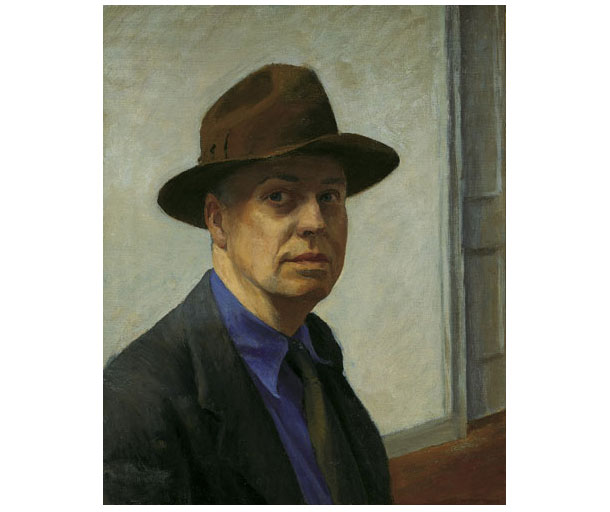
Edward Hopper, a documentary film narrated by actor, art collector and musician Steve Martin, was produced by the National Gallery of Art for an major exhibition there in 2007 that included 48 paintings, 34 watercolors, and 12 prints from public and private collections.
From a IMDb review:
Edward Hopper (1882 – 1967) is one of the best known and most admired of American artists. He found poetry in quiet, private moments set in unexceptional places, such as anonymous hotel rooms, diners (Nighthawks), gas stations, and traditional houses. Within these urban or small-town spaces, Hopper created iconic images of American life that present us with the possibility of narrative, but ultimately remain enigmatic. Rather than depict a specific story, they suggest a universal, shared experience. This film traces Hopper’s varied influences, from French impressionism to the gangster films of the 1930s. The documentary uses archival photos and film, specially shot footage of locations painted by Hopper in New York and the New England coast, and interviews with artists Eric Fischl and Red Grooms, scholars, and curators.
See more about An Opera Inspired by Five Paintings of Edward Hopper after the fold.
Additionally, The National Gallery of Art showed a production of Later the Same Evening: An Opera Inspired by Five Paintings of Edward Hopper, by composer John Musto with libretto by Mark Campbell, was performed at the National Gallery of Art on December 2, 2007. The opera was a joint project of the National Gallery of Art, the Clarice Smith Performing Arts Center, and the University of Maryland School of Music. It was performed by singers from the Maryland Opera Studio and the National Gallery Orchestra. A discussion with the composer, librettist, and cast followed the performance at the National Gallery. Four additional performances were presented at the Clarice Smith Performing Arts Center in November.
Here is a youTube excerpt of this opera
Elaine’s Aria from the Edward Hopper inspired opera
Later the Same Evening
Libretto by Mark Campbell
Music by John Musto
Elaine: Claire Kuttler, soprano





I enjoyed the Hopper documentary. Something I’ve wanted to discuss is the utilitarian approach of many of America’s greatest realists- Homer, Eakins, Hopper, Bellows etc. There seems to be a testy rejection of prettiness, of bravura painting. Although Hopper and Eakins were certainly slow and methodical, you always feel they are just nailing one subject to their satisfaction before moving on to the next. Every time I see a dry and thriftily-painted Hopper oil (not his lovely watercolors), I am reminded that subject comes before style for the realist. He got there first. Far better technical painters have followed his cue, but ‘Hopper-esque’ will remain the word in the dictionary.
Hmm. Funny thing is, having posted this- to begin a seemingly one-way discussion 🙂 – I can only think of a hundred good examples to counter my statement that ‘subject comes before style for the realist’.
Sorry to be so long in commenting back – you are right there are many good counter points to make. One point that comes to mind right off is the notion of bravura painting being in the same camp as “prettiness”. For instance, I think of much of Bellows work as being bravura painting, like Sargent and many other great painters of the day, especially those painting directly from life. Brush work that operates on many levels; thoughtful as well as being passionate, assertive, painterly and visually charged. Working from life, gives the work an edgy, daring quality that studio work can sometimes lack. Hopper, seems more calculating, working in the relative calm of his studio. For what he was going for it made perfect sense. As much as I love Hopper’s slow and methodical style I’m also glad that so many other artists are out there rushing all over the place with a million things and are making different kinds of risks. I’m not sure in the end who is in a better position – the slow, careful painter who plans out his compositions like Hopper who may produce fewer works in the course of a painting career or the painter who works things out on the canvas with little or no preliminary planning and who may make many more paintings over the course of their career but perhaps with a greater percentage of work that didn’t quite pan out… (but like Bellows, when they were good – they were really, really great…)
Good points, Larry. You’re right about Bellows, of course. Interesting you mention poor old Sargent- the 20th Cent. art world never forgave his virtuosity enough to notice his incredible eye for composition, and above all subject matter. Anyway, thanks for keeping up this wonderfully entertaining site, Best, Julyan